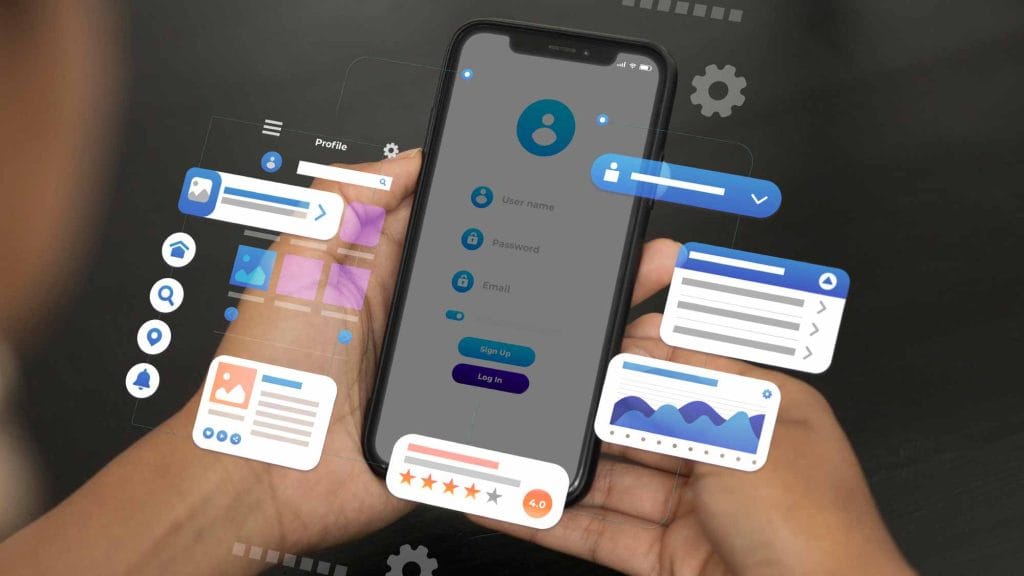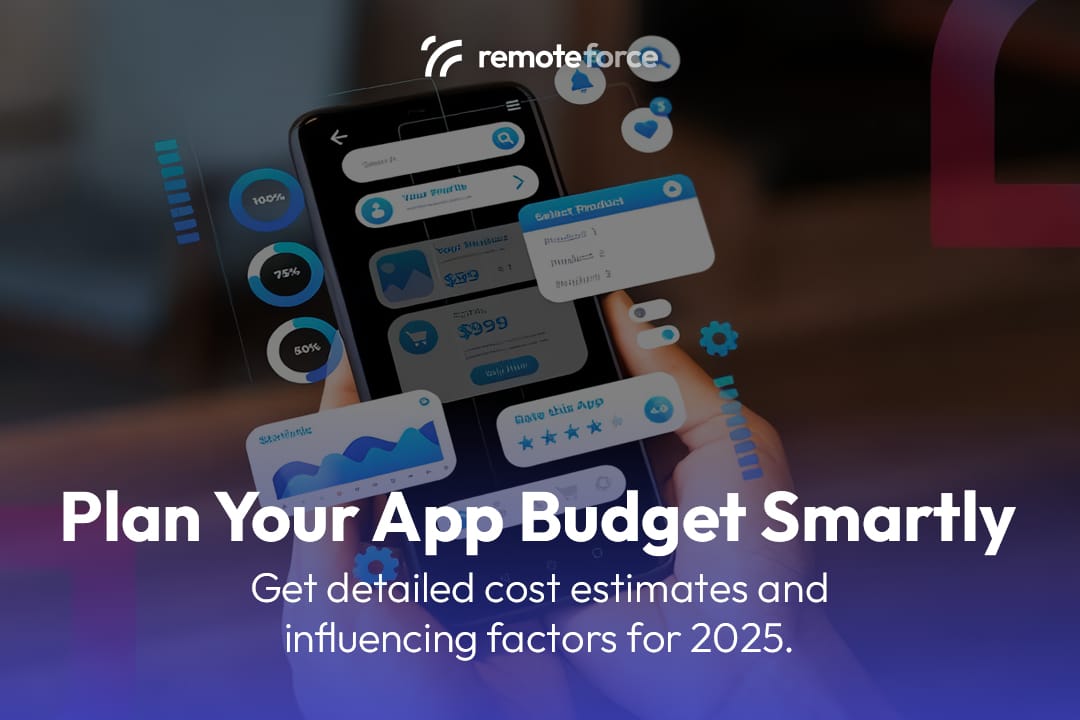In today’s mobile-first world, a well-designed mobile app can be a game-changer for businesses, offering new revenue streams, enhancing customer engagement, and streamlining operations. However, one of the most pressing questions for anyone considering app development is: How much does app development cost in 2025? The answer, unfortunately, isn’t a simple fixed number. App development is an investment, and its cost is influenced by a multitude of factors, much like building a house.
If you’re curious about app development costs and looking for a detailed estimate, or if you want to learn what key factors influence your budget, this guide is for you. We’ll break down the complexities, providing clarity and helping you plan your app investment wisely. Click here to gain insights that will empower your app development journey!
Table of Contents
ToggleKey Takeaways
The cost of app development is a strategic investment, not a fixed price, driven primarily by the required development hours and the location of the development team.
- Complexity is King: The single largest cost driver is App Complexity and the corresponding development hours. Focus ruthlessly on launching a Minimum Viable Product (MVP) with core features to validate the market before expensive feature expansion.
- Platform Strategy: Choosing a Cross-Platform approach (e.g., React Native or Flutter) is the most efficient way to reach both iOS and Android users, potentially reducing the development budget by 30-50% compared to building two separate native apps.
- Budgeting for the Team: App development requires a holistic team (Designer, Front-end, Back-end, QA, Project Manager). Budgeting should account for the cost of all roles across the Planning, Design, and Development phases. *
- The Maintenance Mandate: Always budget an additional 15–20% of the initial development cost annually for post-launch maintenance (OS updates, bug fixes, security patches) to protect your investment and ensure long-term functionality.
The App Economy: A Thriving but Competitive Landscape
The mobile app market continues its explosive growth. In 2024, global mobile app revenues reached over $600 billion, with projections indicating continued increases in 2025 and beyond. This thriving economy presents immense opportunities, but also means increased competition. To stand out, your app needs to be well-planned, expertly executed, and offer genuine value to users.
Understanding the investment required upfront is crucial for budgeting, securing funding, and setting realistic expectations. The cost of an app can range from a few thousand dollars for a very simple application to hundreds of thousands or even millions for complex, feature-rich platforms.
How Much Does App Development Cost in 2025? Factors Influencing Your Budget

Let’s dissect the primary factors that dictate the final price tag of your mobile application.
1. App Complexity and Features
This is arguably the most significant cost driver. The more features and intricate functionalities you want, the more development hours will be required.
- Simple Apps (e.g., Basic Utility, Information-only):
- Features: Basic UI, limited user interactions, static content, simple data display.
- Examples: Calculator, simple to-do list, basic content viewer, flashlight app.
- Estimated Cost: $15,000 – $40,000
- Development Time: 1-3 months
- Medium Complexity Apps (e.g., Standard Features, Some Integrations):
- Features: User login/profiles, API integrations (social media, payment gateways), push notifications, basic search, custom UI elements, chat functionality.
- Examples: Basic e-commerce app, simple social media app, ride-sharing MVP, booking apps.
- Estimated Cost: $40,000 – $120,000
- Development Time: 3-6 months
- Complex Apps (e.g., Advanced Features, Real-time Integrations, AI/ML):
- Features: Custom animations, real-time synchronization, advanced analytics, video/audio streaming, AI/ML integrations, IoT connectivity, sophisticated security, multiple payment options, complex backend.
- Examples: Large-scale social networks, complex e-commerce platforms, on-demand service apps (Uber, Airbnb), gaming apps with intricate mechanics.
- Estimated Cost: $120,000 – $500,000+
- Development Time: 6-12+ months
Value-Add: To manage costs, consider an MVP (Minimum Viable Product) strategy. Launch with core features to test the market, gather feedback, and then iterate and add more features in subsequent phases. This helps validate your idea without a massive upfront investment.
2. Platform (iOS, Android, or Cross-Platform)
Your target audience will dictate which platforms you need to support, directly impacting cost.
- Native iOS Development: Building specifically for Apple’s ecosystem (iPhones, iPads) using Swift/Objective-C. Generally, a bit more expensive than Android due to higher developer rates and often a focus on premium UI/UX.
- Native Android Development: Building specifically for Android devices using Java/Kotlin. Covers a wider range of devices and screen sizes, which can add complexity.
- Cross-Platform Development (e.g., React Native, Flutter): Building a single codebase that runs on both iOS and Android.
- Pros: Significantly reduces development time and cost (often 30-50% less than two native apps), easier maintenance.
- Cons: May have minor limitations in accessing very specific native device features or achieving pixel-perfect platform-specific UI.
- Impact: If you need to reach both iOS and Android users and budget is a concern, cross-platform is often the most cost-effective solution.
Also Read: Understanding the App development Lifecycle Step by Step
3. Design (UI/UX)
A well-designed app is crucial for user adoption and retention.
- Basic UI/UX: Standardized templates, minimal custom graphics.
- Custom UI/UX: Unique, branded design tailored to your app’s purpose, extensive wireframing, prototyping, and user testing. This adds significant cost but also significant value.
- Animations & Interactions: Complex animations and fluid transitions enhance user experience but require more design and development effort.
Expert Insight: “Don’t skimp on UI/UX,” advises a leading app designer. “A beautiful, intuitive app reduces user frustration, boosts engagement, and ultimately leads to better conversion rates. It’s an investment, not an expense.”
4. Developer Location and Team Structure
Where your development team is located and how they’re structured greatly influences hourly rates.
- North America/Western Europe: Highest hourly rates ($100-$250+ per hour). Offers high quality, strong communication, and cultural alignment.
- Eastern Europe/Latin America: Mid-range rates ($50-$100 per hour). Excellent quality, skilled professionals, and often a good balance of cost and expertise.
- Asia (e.g., India, Southeast Asia): Lower hourly rates ($25-$60 per hour). Can be cost-effective, but careful vetting is essential for quality and communication.
- Freelancers vs. Agencies: Agencies often provide a full team (project manager, UI/UX designer, frontend, backend, QA), offering a more structured approach and accountability, but typically at a higher overall cost. Freelancers can be more budget-friendly but require more oversight from you.
5. Backend Infrastructure and APIs
Unless your app is completely static, it will need a backend.
- Custom Backend Development: Building a server, database, and APIs from scratch. Provides maximum flexibility but is more expensive.
- Backend as a Service (BaaS): Using cloud-based services (like Firebase, AWS Amplify) that handle server infrastructure, authentication, databases, etc. Can significantly reduce backend development costs and time for many apps.
- Third-Party API Integrations: Integrating with external services (e.g., Google Maps, Stripe, Twilio) saves development time but may incur per-use costs or subscription fees from those services.
6. Post-Launch Maintenance and Support
App development doesn’t end at launch. This is an ongoing cost.
- Bug Fixes & Performance Monitoring: Addressing issues that arise post-launch.
- Updates & New Features: Adding new functionalities based on user feedback or market trends.
- OS Updates: Ensuring compatibility with new versions of iOS and Android.
- Security Patches: Protecting your app from new vulnerabilities.
- Server & Database Maintenance: Ongoing costs for hosting, data storage, and server management.
- Estimated Maintenance Cost: Typically 15-20% of the initial development cost annually.
Planning Your App Investment Wisely
To get a more precise estimate for your app:
- Define Your MVP Clearly: List the absolute core features your app must have for its initial launch.
- Research Competitors: Analyze apps with similar functionality to get an idea of what works and what users expect.
- Prioritize Features: Categorize features as “Must Have,” “Nice to Have,” and “Future Release.”
- Get Detailed Quotes: Provide comprehensive requirements to development agencies for accurate estimates.
- Factor in Hidden Costs: Don’t forget marketing, app store listing fees, ongoing maintenance, and potential legal costs.
Conclusion: A Strategic Investment in Your Digital Future
How much does app development cost in 2025? While there’s no single answer, understanding the key factors – app complexity, platform choice, design intensity, developer location, backend needs, and ongoing maintenance – allows you to make informed decisions and budget effectively.
Developing a mobile app is a strategic investment that, when done right, can yield significant returns by enhancing user engagement, expanding your reach, and driving business growth. Don’t view it as an expense, but as a crucial step towards securing your digital future.
If you’re ready to bring your app idea to life and need clear, transparent estimates and expert guidance through every stage of development, partnering with a seasoned team is essential. At RemoteForce, we specialize in comprehensive web and app development services, offering tailored solutions that align with your vision and budget.
Our experienced developers and designers work collaboratively to build high-quality, user-centric applications, ensuring your investment delivers maximum impact. Beyond web and app development, RemoteForce also offers digital marketing, graphic design, secretarial, legal, and accounting services, providing a holistic suite of solutions to empower your entire business.
Ready to turn your app idea into a reality with a clear budget in mind? Contact RemoteForce today for a detailed consultation and estimate for your app development project!
Frequently Asked Questions (FAQ)
1. What are the “hidden” costs I should budget for besides development?
Beyond the core development cost, you must budget for:
- App Store Fees: Annual registration fees for Apple Developer Program (USD 99) and Google Play Developer Account (USD 25 one-time).
- Server/Hosting Costs: Monthly fees for cloud services (AWS, Google Cloud, Azure) which scale with your user base.
- Third-Party Services: Subscription costs for APIs (e.g., advanced analytics, SMS services, marketing automation tools).
- Legal Costs: Drafting Terms & Conditions, Privacy Policy, and any necessary legal agreements.
2. How can I reduce development costs without sacrificing quality?
- Launch an MVP: Focus on the single, core value proposition and cut all non-essential features for V1.
- Choose Cross-Platform: Use React Native or Flutter instead of dual native development.
- Use BaaS/Off-the-Shelf APIs: Leverage existing cloud services (like Firebase) and standard APIs (like Stripe) instead of building custom backend solutions.
- Outsource Strategically: Partner with agencies in locations that offer strong expertise at lower hourly rates (e.g., Southeast Asia).
3. Should I use a fixed-price or time-and-materials contract?
- Fixed-Price: Best for MVPs or small, simple projects with extremely well-defined and unchanging requirements. Provides cost certainty but lacks flexibility.
- Time-and-Materials (T&M): Best for complex, large-scale projects where requirements may evolve, or for the maintenance phase. Provides flexibility to adapt to market feedback but requires diligent budget monitoring. For most innovative apps, T&M is recommended.
4. What percentage of the budget should I allocate to post-launch maintenance?
A realistic budget for the first year of post-launch maintenance and updates should be 15% to 20% of the initial development cost. This covers essential fixes, OS compatibility, security updates, and minor feature iterations necessary for stability and competitive relevance.




